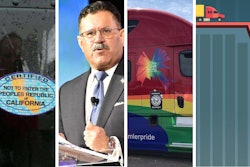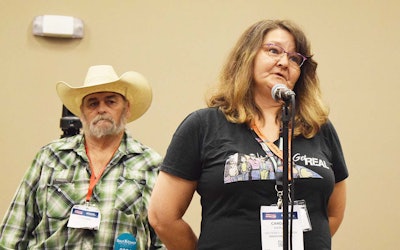 Owner-operator Candace Marley advocated for allowing drivers to take multiple, shorter breaks to satisfy the 30-minute break requirement.
Owner-operator Candace Marley advocated for allowing drivers to take multiple, shorter breaks to satisfy the 30-minute break requirement.Kicking off the formal comment period for the Federal Motor Carrier Safety Administration’s proposal to enact hours of service reforms, owner-operators and other stakeholders took the mic before FMCSA’s top decision makers at a public listening session Friday, Aug. 23 at the Great American Trucking Show.
Though the subject of split sleeper berth provisions was a common talking point among those who commented, it was another split that drew more attention — the ability for drivers to divide their required 30-minute break into multiple, shorter breaks. Instead of a hard 30-minute break, several pushed for allowing a cumulative break, in which drivers could take three 10-minute stops or two 15-minute stops to satisfy the 30-minute break requirement.
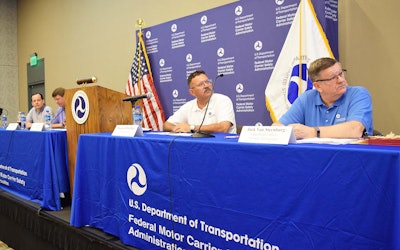 FMCSA Administrator Ray Martinez (second from right) heard feedback from owner-operators and other industry stakeholders in a listening session at the Great American Trucking Show on Friday, Aug. 23, alongside Jack Van Steenburg (far right), Wiley Deck (far left), Jim Mullen (second from left) and Larry Minor (behind the podium).
FMCSA Administrator Ray Martinez (second from right) heard feedback from owner-operators and other industry stakeholders in a listening session at the Great American Trucking Show on Friday, Aug. 23, alongside Jack Van Steenburg (far right), Wiley Deck (far left), Jim Mullen (second from left) and Larry Minor (behind the podium).“Let’s encourage more movement throughout the day,” said Candace Marley, who recently transitioned from a company driver to a leased owner-operator. Prior to the 2013 enactment of the 30-minute break rule, Marley said she stopped multiple times a day for shorter breaks, which often added up to more than 30 minutes in breaks. Now, she says, she tries to drive five straight hours before taking the 30-minute break.
“I don’t like it,” she said. “But I have do it all the time. I need to move my legs every couple hours and not have to worry about that 30-minute break too. Let our breaks be broken up and accumulate those minutes.”
“A lot of drivers hate it and a lot of drivers think it’s great,” said owner-operator Rich McCormick of the 30-minute break. “But it would be nice to be able to split it up. At my age, driving down the road, I’m not going to be able to drive [long] without stopping to use the restroom. If I had two [15 minute breaks], I could still stop and be able to stretch and walk around. Sometimes I’ll stop for 15 minutes, but when I get close to the 8 hours, I have to take another 30-minute break to satisfy” the regulations. “And I’m just twiddling my thumbs waiting” for the break to end, he said.
“On the 30-minute break, we’d like to see it go away,” said Lewie Pugh, executive vice president of the Owner-Operator Independent Drivers Association, speaking on behalf of the group. “If it’s not going away, why can’t [drivers] break that up into two 15 minute breaks or a 10 and a 20? With ELDs, you can clock every single solitary second. Wouldn’t it be better if [drivers] stopped for three 10-minute breaks? Why does i t have to be a whole 30 minutes?”
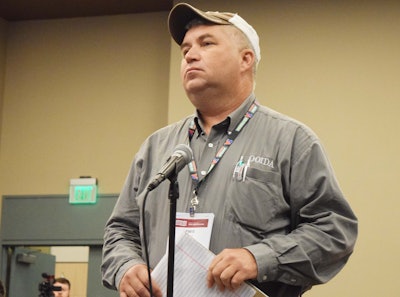 OOIDA Executive Vice President Lewie Pugh was among those who asked the agency to allow drivers to split their 30-minute break into multiple breaks.
OOIDA Executive Vice President Lewie Pugh was among those who asked the agency to allow drivers to split their 30-minute break into multiple breaks.The public comment period on FMCSA’s hours-of-service notice of proposed rulemaking began Thursday. Friday’s listening session was the first of two planned listening sessions, though the agency could announce other listening sessions during the 45-day comment period. In short, FMCSA has proposed allowing drivers to pause their 14-hour on-duty clock for up to three hours, allowing more flexibility around the 30-minute break requirement, and a 7/3-hour revision to the split-sleeper regs. Read about the changes in full at this link.
In attendance from FMCSA were Administrator Ray Martinez; Larry Minor, associate administrator; Jack Van Steenburg, chief safety officer; Wiley Deck, head of government affairs; and Jim Mullen, the agency’s chief counsel.
Pugh also pondered whether drivers could “stack” some of the potential provisions, noting that the potential three-hour pause and the proposed adverse driving conditions on-duty extension could put a driver’s day close to the 20-hour mark.
Likewise, long-time Landstar owner-operator Gary Buchs posed concerns about the safety impact of unnecessarily long work days, as well as potential abuse by some drivers of the adverse driving conditions proposal.
Ricky Von Honaker, safety director at Texas-based fleet TX Loadrunners, asked the agency to update and clarify the definition of what constitutes adverse driving conditions that would allow drivers to extend their duty day and drive time. The decision to use the adverse conditions exemption “100%…should be with the driver,” said Von Honaker. “But the current definition is a little vague for drivers.”
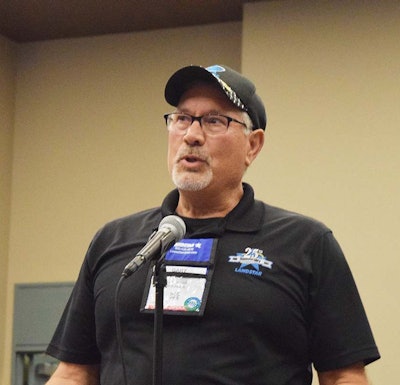 Owner-operator Gary Buchs.
Owner-operator Gary Buchs.The session was much more relaxed than the listening session held at least year’s Great American Trucking Show, when the agency was accepting public comments on whether to take up an hours of service reform rule and what should be included if so. Last GATS, the meeting room where the listening session was held was packed from the onset. This year, in the same room, there were plenty of empty seats as the session began, with drivers coming and going through the two-hour session. A few dozen drivers made oral comments at the meeting, and FMCSA read several written comments filed for the meeting. Also, several truckers provided oral comments via the live webcast.
The public comment period for the agency’s hours proposal ends Oct. 7, and comments can be filed at this link. At the session, FMCSA Administrator Ray Martinez encouraged drivers and other stakeholders to file comments, noting the agency will lean on those comments in developing a final rule for hours of service regulations. The final rule will likely take months, if not longer, to be finalized. Then, the new regs would likely not take effect for another year or more after it is finalized and published.
FMCSA will hold a second listening session in September in Washington, D.C., at DOT’s headquarters. The dates and times for that session have not been announced yet.


